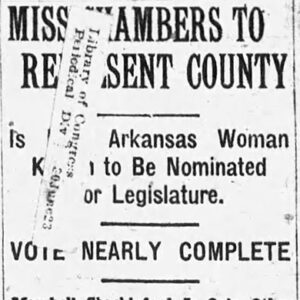calsfoundation@cals.org
Erle Rutherford Chambers (1875–1941)
Erle Rutherford Chambers was a pioneering woman in Arkansas in the early part of the twentieth century. In addition to being the first woman to graduate from the Law Department of the University of Arkansas, she was also the first to be elected to the Arkansas General Assembly.
Erle Rutherford Chambers was born in 1875 in Tennessee to Thomas Chambers and Henrietta Davidson Chambers. She had one younger sister. Little is known about her youth or when she came to Arkansas, but she worked as a teacher before moving into law. Chambers had become interested in the law as a secretary in the Little Rock (Pulaski County) firm of Moore, Smith and Trieber. She began her legal studies while still working with the firm, and in 1912 she graduated from the Law Department of the University of Arkansas, then located in Little Rock, becoming the school’s first female graduate. She undertook further study at the law school of the University of Chicago. Despite her extensive academic legal training, the state did not allow women to be admitted to the state bar, a practice that was finally changed in 1917. Chambers never practiced.
In 1913, Chambers was named a Pulaski County probation officer, a post she held until 1917. As a probation officer, she fought to get the government to establish a state industrial schools for girls, and she also pushed for the conversion of an existing boys’ reform school into a comparable industrial school for boys. During this same period, she also played a central role in the creation of a boys’ club in Little Rock. In 1916, while serving as field secretary of the State Public Health Association, she went around the state addressing local city councils on the issue of sanitation, encouraging local governments to undertake greater efforts to clean up their towns. Those efforts, which received recognition from the Arkansas Medical Society, resulted in many local municipalities holding “clean up days” to improve sanitation conditions. In 1919, she helped organize a statewide conference for educators on better health conditions.
In 1919, Chambers became executive secretary of the Arkansas Tuberculosis Association, a position she held until her death in 1941. She was an unrelenting advocate for the establishment of a state sanatorium for African Americans. She is widely recognized as the originator of the idea, one offered not without risk in the racially charged atmosphere of the era.
In 1922, Chambers was recruited by the League of Women Voters to run for the state legislature. Elected to the Arkansas House of Representatives—the first woman from Pulaski County to be elected and the first to be sworn into the House of Representatives—she took her seat in 1923. While she would serve only a single two-year term in the House before opting out of the political process, Chambers played an active role in the legislative process and proved to be a skilled political operator. In addition to securing passage of a bill that eliminated a husband’s right of curtesy (his interest upon the death of his wife in the estate that she either solely owned or inherited as long as they bore a child who could inherit the estate), a pioneering piece of legislation that impacted important property rights, she co-sponsored numerous bills relating to infants and women, while also advocating the creation of a commission for the care of the blind.
Bringing her previous efforts to secure the creation of a state tuberculosis sanatorium for the state’s African Americans into the legislative arena, she introduced a bill authorizing the establishment of such an institution. With the help and support of Governor Thomas McRae, her efforts were rewarded in 1923 with the passage of legislation that authorized the construction of such a facility. Chambers was among those the governor named to a board that was charged with finding a suitable location and making the appropriate plans while he went back to the legislature to secure funding. In 1930, Chambers’s dream was achieved with the construction of the Thomas C. McRae Sanatorium in Alexander (Pulaski and Saline counties). In 1935, when New Deal Works Progress Administration (WPA) funds allowed for the construction of a second structure and the expansion of the McRae facility, the new building was named for Chambers.
In 1924, Chambers served as the floor manager for the effort to ratify the Child Labor Amendment to the U.S. Constitution. Under her leadership, Arkansas became the first state to ratify the amendment.
Choosing not to run for reelection, Chambers devoted the rest of her life to her work with the Arkansas Tuberculosis Association. She died on January 9, 1941, and is buried in the Oakland and Fraternal Historic Cemetery in Little Rock.
For additional information:
Dillman, Caroline Matheny. Southern Women. New York: Routledge, 1988.
Dorough, Mrs. W. T. “The First Woman Legislator in Arkansas: A Tribute to Miss Erle Chambers.” Pulaski County Historical Review 32 (Summer 1984): 32–34.
“Miss Erle R. Chambers Succumbs.” Arkansas Gazette, January 10, 1941, p. 14.
Ross, Frances Mitchell. “Reforming the Bar: Women and the Arkansas Legal Profession.” University of Arkansas at Little Rock Law Review 20.4 (1998): 869–890. Online at http://lawrepository.ualr.edu/cgi/viewcontent.cgi?article=1628&context=lawreview (accessed August 21, 2020).
William H. Pruden III
Ravenscroft School
 Early Twentieth Century, 1901 through 1940
Early Twentieth Century, 1901 through 1940 Politics and Government
Politics and Government Erle Rutherford Chambers
Erle Rutherford Chambers  Erle Rutherford Chambers
Erle Rutherford Chambers  Hunt and Chambers
Hunt and Chambers 




Comments
No comments on this entry yet.